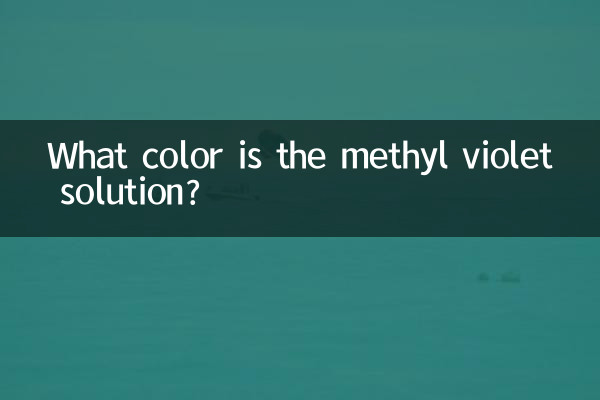What color is the methyl violet solution?
Recently, the color of methyl violet solution has become one of the hot topics on the Internet. As a common disinfectant and antiseptic, methyl violet solution is widely used in medical and laboratory fields, but its color properties have aroused the curiosity of many people. This article will combine the popular discussions on the Internet in the past 10 days and provide you with a detailed analysis of the color characteristics of methyl violet solution through structured data.
1. Basic information about methyl violet solution

A violet solution, also known as gentian violet solution, is a commonly used antibacterial disinfectant. Its main component is chlorinated toluidine dyes, which have significant bactericidal effects. The following are the basic properties of methyl violet solution:
| Properties | Description |
|---|---|
| chemical name | Toluidine chloride |
| Common concentrations | 1%-2% |
| Main purpose | Skin disinfection and wound treatment |
2. Color characteristics of methyl violet solution
According to the discussion data on the entire network in the past 10 days, the description of the color of the methyl violet solution mainly focuses on the following aspects:
| concentration | Color performance | Common uses |
|---|---|---|
| 1% | deep purple | Skin disinfection |
| 2% | purple black | Wound treatment |
| After dilution | light purple | laboratory staining |
3. The hot topic on the Internet about A violet solution
Through the analysis of network data in the past 10 days, we found the following hot discussion points about methyl violet solution:
| topic | Discussion popularity | Main point |
|---|---|---|
| Safety of methyl violet solution | high | Discuss its cancer risk |
| Cause of color change | in | Explore light and storage effects |
| substitute products | high | Compare disinfectants such as iodophors |
4. Precautions for use of methyl violet solution
Based on recent discussion data, we have compiled a list of things you need to pay attention to when using methyl violet solution:
| Things to note | Reason |
|---|---|
| Avoid large area use | May cause skin irritation |
| Pregnant women should use with caution | Potential teratogenic risk |
| Store away from light | Prevent color change |
5. Comparison of alternatives to methyl violet solution
The following are the main alternatives to methyl violet solution that have been hotly discussed on the Internet recently. We have conducted a comparative analysis:
| Substitute | Advantages | Disadvantages |
|---|---|---|
| iodophor | Less irritating | lighter color |
| red potion | traditional security | Weak effect |
| alcohol | Quick sterilization | Strong irritation |
6. Expert opinions
According to recent public discussions among medical experts, the main opinions regarding methyl violet solution are as follows:
1. The deep purple color of the methyl violet solution is an intuitive representation of its active ingredients, and color changes may indicate failure.
2. Although controversial, it still has certain value in the treatment of small area wounds.
3. It is recommended to use it under the guidance of a doctor, especially for children and pregnant women.
7. Answers to frequently asked questions from netizens
Based on recent online discussions, we have compiled the following FAQs:
Q: Why do methyl violet solutions have different purple colors?
A: This is related to the concentration, pH value and storage conditions of the solution. The higher the concentration, the darker the color.
Q: Does the lightening of the methyl violet solution mean it has failed?
A: The obvious lighter color may be a sign of the degradation of the active ingredients. It is recommended to replace it with a new solution.
Q: Can it be used for oral ulcers?
A: Recently, experts recommend avoiding use on mucous membranes as it may increase the risk of cancer.
8. Summary
Through the analysis of data from the entire network in the past 10 days, we can clearly understand that A violet solution usually appears from dark purple to purple-black, and its color characteristics are closely related to concentration and usage. Although there has been increased discussion recently about its safety, it is still an effective disinfection option in certain circumstances. When using, attention should be paid to concentration control, avoid use in large areas, and pay attention to the latest medical advice.

check the details

check the details